Dip Pen Nibs For Drawing
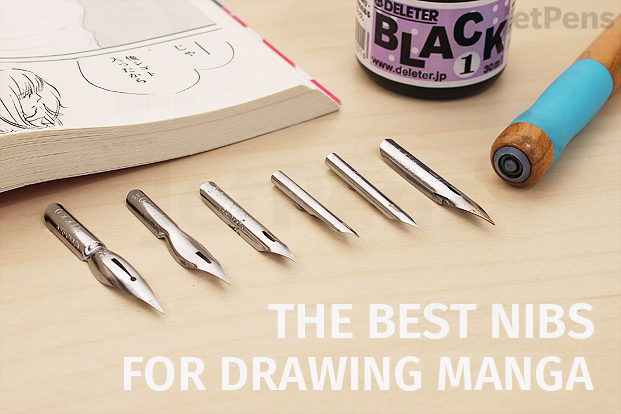
Comic artists have a wealth of tools at their disposal, including technical drawing pens, brush pens, and more. So why bother with a nib? Manga pen nibs are actually quite versatile--unlike technical drawing pens, they are flexible enough to provide expressive line variation and create different effects, but easier to control and draw finer lines than brush pens. From sketching to outlining to filling in details, it's easy to see why manga nibs are artist staples. Keep reading to see our favorites and find out more about the different kinds of nibs that manga artists use.
Why Manga Nibs?
There are many different nibs available on the market that are used in everything from basic writing to calligraphy to drawing. Calligraphy and writing nibs are available as both pointed or italic tips with varying degrees of flexibility. While some calligraphy nibs can be used for drawing, manga nibs are specifically created to meet an artist's needs. Usually pointed, firm, and slightly flexible, manga nibs produce thin, controlled lines and flex only when a good amount of pressure is applied, allowing artists to be precise and deliberate in their drawings.
Considerations
Flexibility

Flexible (left) versus not flexible (right)
Flexibility refers to how much a nib is able to bend when pressure is applied. Manga nibs range from extremely hard (not flexible) to moderately soft (flexible). Unlike in calligraphy, too much flexibility in a nib is undesirable as it is more difficult to control and can cause a piece to look messy. However, having some flex in a nib allows artists to play with different textures and strokes to provide more depth and expression.
Elasticity

Extremely elastic (top) nibs spring back to their original shape quickly compared to slightly elastic (bottom)
A nib is elastic if it springs back to its original shape after pressure is applied. It's important for nibs to be elastic so that they retain their shape; however nibs that are too elastic tend to be harder to control. The same amount of pressure has to be applied constantly to get a consistent line. With very elastic nibs, any slight change in pressure will change the way a line looks, which expert manga artists use to their advantage. On the other hand, beginners should start with less elastic nibs as they are more easily controlled.
Line Width
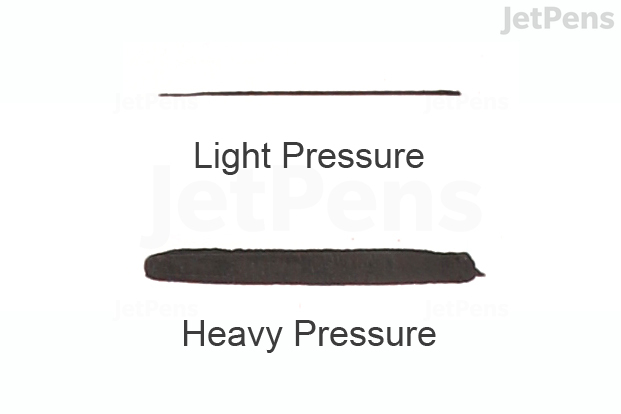
Thin (top) and thick (bottom) line width created using the same nib
Comic nibs usually keep consistent line widths, but a few nibs provide a variable amount of line variation. Depending on how it's held or how much pressure is applied, nibs may produce thin to thick lines. Nibs that maintain an even line width are good for drawing inanimate objects, man-made objects, and scenery, while nibs with variable line widths are ideal for depicting animate objects and movement.
Manga Nib Types
Now that you know what to look for in a manga nib, let's take a look at the different types of nibs available. The G nib is an artist favorite, but beginners should consider the School or Japanese nibs as they are easier to use.
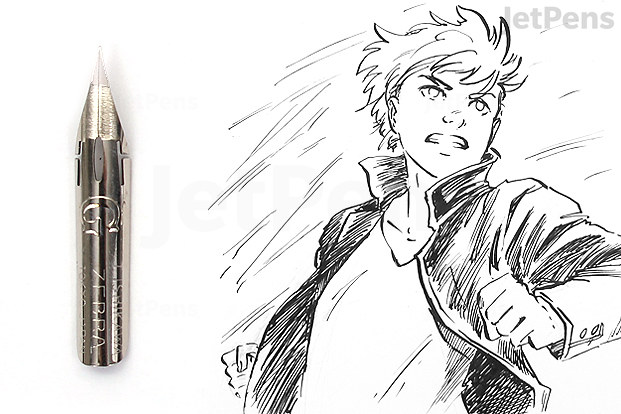
The ultimate and most famous manga nib is the G nib. The most flexible among manga nibs, the G nib creates fine to bold lines depending on the amount of pressure applied. It's perfect for drawing people, expressions, showing distance, and other movement. We especially like the Zebra G Nib, because it's slightly more flexible than other G nibs, but it does make it more difficult to control. The G Nib is more suited to advanced artists--we recommend Zebra's Hard G Nib for those just starting out.
Good for: People, movement
Staff Pick: Zebra G
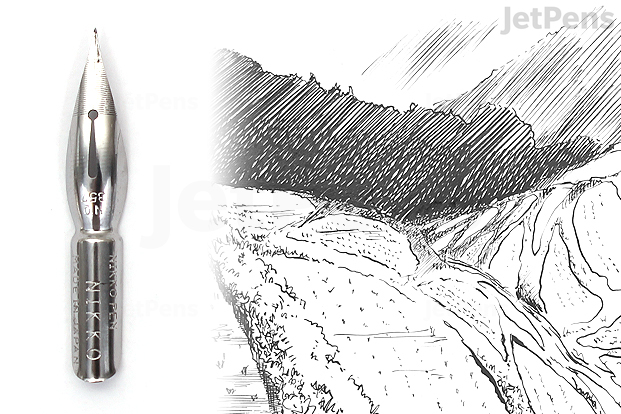
The Spoon nib is also known as the Saji or Tama nib, and is easily distinguishable by its oblong, spoon-like design. It's a good choice for beginners who aren't quite ready for the G nib as it's quite hard and produces fine, even lines. If used on its side, it can create thick lines. When working with such consistent line widths, a drawing can end looking flat or expressionless. Be mindful of that when using this nib.
Good for: Inanimate objects, scenery
Staff Pick: Nikko Spoon
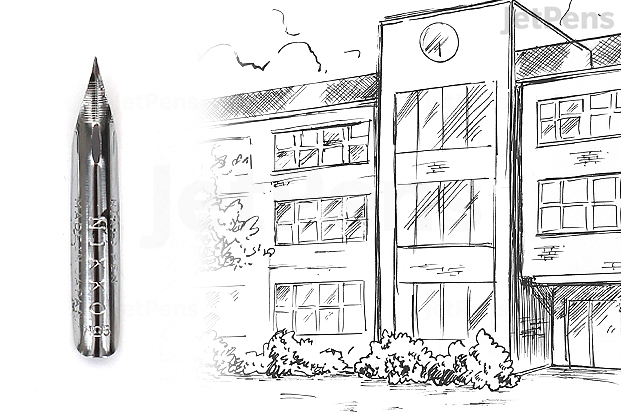
Another great pick for the budding artist is the School nib. It's smaller than most nibs, making it easier to control than other longer, unwieldy nibs (like the Spoon nib above). Originally used for bookkeeping, it produces fine, consistent lines, but is slightly flexible. This allows beginners to practice line variation before they move onto more flexible nibs, such as the G nib. Advanced users love this nib for drawing manmade objects, such as architecture and cars, or scenery and landscapes.
Good for: Inanimate objects, scenery
Staff Pick: Nikko School

The Japanese nib, or Nihonji nib, was optimized to write the curves and hooks of Japanese script. Because of this, it has better maneuverability and flexibility than the School nib. It's also not as elastic as the G nib, making it easier to maintain a constant line width. If you're looking for a nib that can do it all, we suggest looking into the Japanese nib.
Good for: General use, Japanese script, curves
Staff Pick: Nikko Japanese

Also known as a maru nib, the mapping nib is the preferred choice for shojo manga (manga aimed at teenage female readership) artists. This nib draws the finest of lines, ideal for the soft look of shojo manga. Even with a lot of pressure, the nib keeps consistent lines. The delicate, hair-like strokes of the mapping nib are just what an artist needs for tiny details. Mapping nibs are smaller and a different shape from most nibs, so be sure to pair it with a compatible nib holder.
Good for: Small details
Staff Pick: Tachikawa Mapping
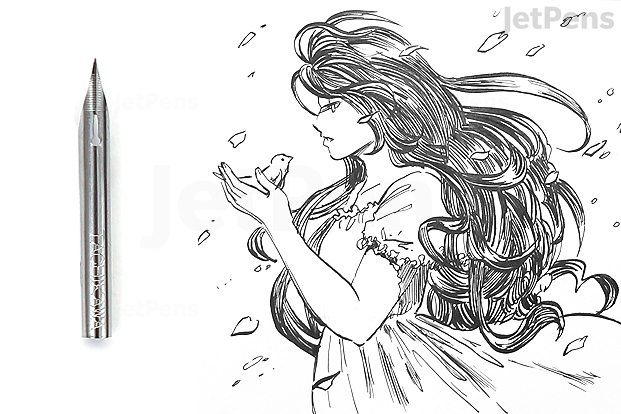
As the name suggests, the soft maru nib is a flexible version of the maru nib. This nib is perfect for artists who love the tiny lines of the maru nib, but prefer the flexibility of the G nib. Where the standard maru nib is good for small, concentrated details, the soft maru nib is great for long, curved details, such as for drawing long hair. Be careful when applying pressure to this delicate nib--it's prone to splaying if used too roughly.
Good for: Curved details
Staff Pick: Tachikawa Soft Mapping
Manga Nib Accessories
Nib Holder
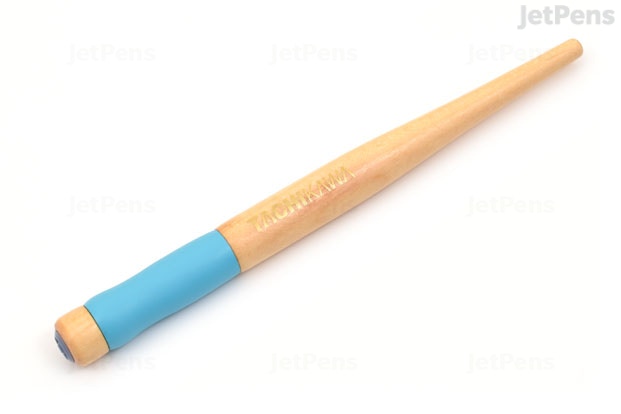
In order to use a nib, you need to fit it into a nib holder. Nib holders are usually wooden or plastic and come in straight or oblique shapes. Different nibs fit in different holders, so see our Guide to Nibs and Nib Holders for more on nib and nib holder compatibility. The Tachikawa 40 nib holder is one of our favorites as it has two slots that can hold a regular nib and the smaller mapping nib.
Drawing Ink

Finding the right ink is also important. Drawing inks come in varying degrees of darkness, gloss, dry time, and water resistance. Check out our Guide to Drawing Inks for an in-depth look at the different drawing inks we offer. In the table below, we used the J. Herbin India Ink as it's incredibly black with a lovely semi-gloss finish and shows off each nib's qualities admirably.
Paper
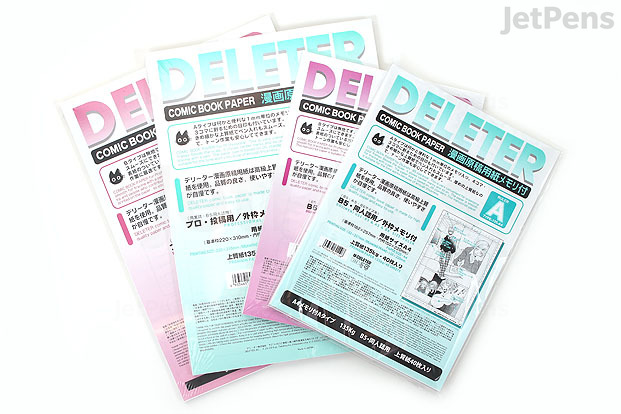
A nib's pointed tip is liable to snagging on low-quality or toothy paper. We suggest a smooth, heavy comic paper like the Deleter Comic paper for a pleasant, catch-free drawing experience.
Conclusion
Drawing with manga nibs can be intimidating, but with practice and perseverance, they'll become essentials in your arsenal of tools. If you're still not sure what nibs to try, check out Tokyo Slider's Nikko or Tachikawa Comic Pen Nib Sets--they come with five different nibs for you to sample them all! You can also take a peek at our Comic and Manga Supplies selection guide for other comic tools.
| Name | Flexibility | Elasticity | Line Width | Good For | Skill Level |
|---|---|---|---|---|---|
| G Nib | High | High | Fine to broad | People, movement | Intermediate/Advanced |
| Spoon Nib | Low | Low | Fine/Broad | General use | Intermediate |
| School Nib | Low | Medium | Fine | Inanimate objects, scenery | Beginner |
| Japanese Nib | Medium | Low | Fine to medium | Japanese script, curvese | Beginner |
| Mapping Nib | Low | Medium | Extra fine | Small details, shojo manga | Beginner |
| Soft Mapping Nib | High | High | Extra fine to fine | Curved details | Advanced |
Related Posts
Dip Pen Nibs For Drawing
Source: https://www.jetpens.com/blog/the-best-nibs-for-drawing-manga/pt/893
Posted by: millercrummon.blogspot.com




0 Response to "Dip Pen Nibs For Drawing"
Post a Comment